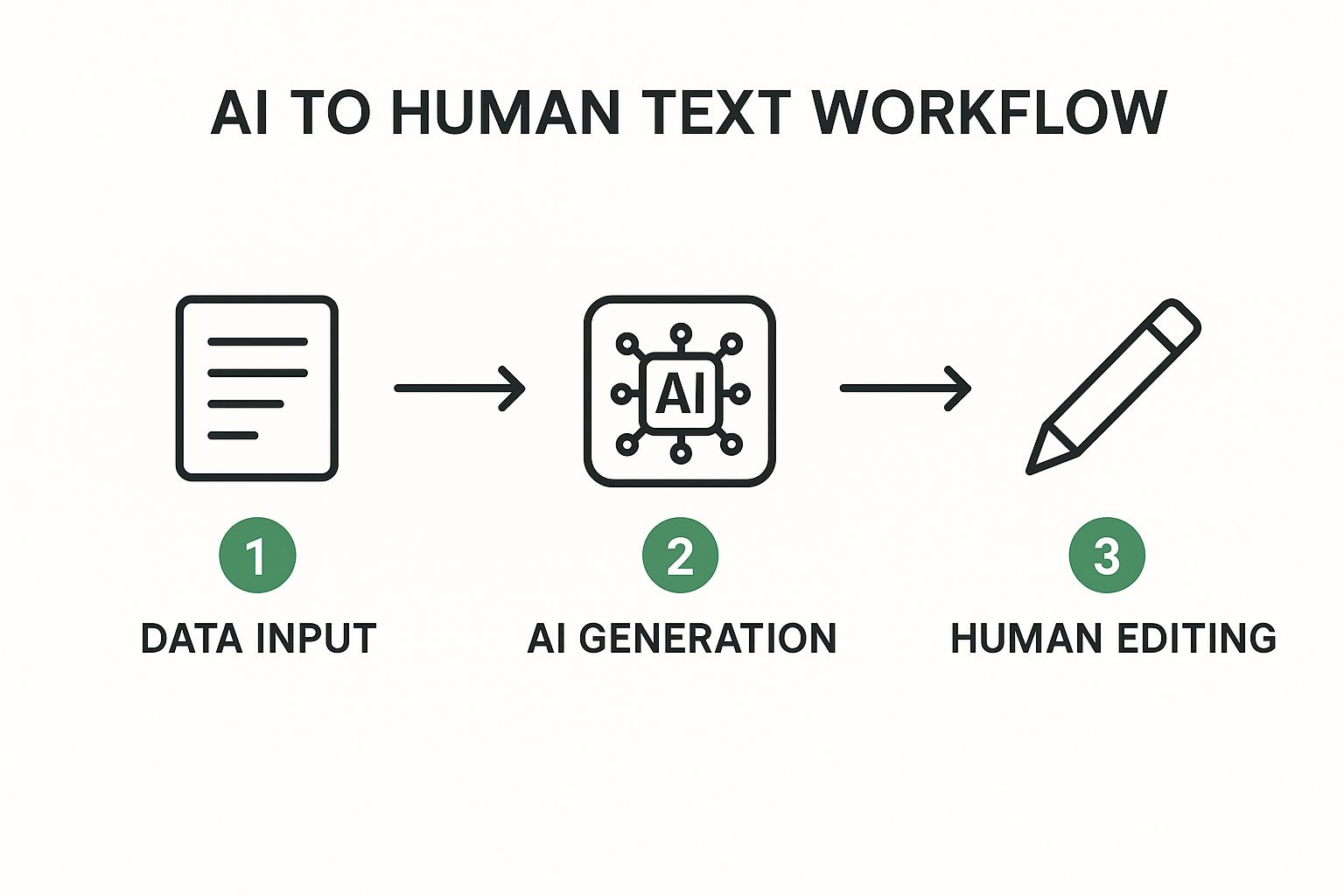
Making AI to Human Text Sound Authentic
October 3, 2025
Turning a first draft from an AI into something that truly connects with people is more than just a quick spell-check. It's about injecting the personality, lived experience, and unique voice that raw AI output just can't replicate. While AI is an incredible starting point, the content it produces often feels generic and flat, failing to build a real relationship with your readers.
Why Raw AI Content Often Misses The Mark

Let's be real—raw AI-generated text can feel lifeless. It might be grammatically perfect and structured logically, but it lacks the spark that builds trust and keeps an audience engaged. This is exactly why the conversation has shifted from just generating content to the crucial process of making it sound genuinely human.
Before you can fix it, you have to know where it comes from. Most of this content is cranked out by various AI content generation tools. These platforms are built for speed and scale, not for nuance, personality, or authentic connection.
The Unmistakable Signs Of Unedited AI
Unedited AI drafts have some classic giveaways. Savvy readers—and increasingly, search engines—are getting better at spotting them. These robotic tells can tank your credibility before a reader even gets through the first few paragraphs.
Here are a few things that scream "a robot wrote this":
- Predictable Sentence Patterns: AI loves falling into a rut, using the same sentence structures over and over. This creates a monotonous rhythm that can put anyone to sleep.
- A Lack Of Personality: The text is a ghost. There's no distinct brand voice, no point of view—it reads more like a bland summary than an insightful piece of content.
- Generic Filler Language: You'll see the same old crutches: phrases like "in conclusion," "it is important to note," or "delving deeper" pop up everywhere.
The core issue isn't that AI is a bad writer. It's that it can't replicate lived experience. It simulates understanding but doesn't actually possess it, which is why a human touch remains non-negotiable for creating top-tier content that people want to read and share.
Why The Human Touch Is Non-Negotiable
It's clear that AI has a firm place in modern content workflows. Recent data shows that 71.7% of marketers use it for outlining and 57.4% lean on it for drafting. This has led to traffic growth for many, but the final quality still comes down to human refinement.
The reason is simple: both your audience and search engines value content that demonstrates real expertise and a unique voice. Without that human element, you risk getting lost in a sea of identical-sounding articles. If you're curious about how this is detected, you can learn more by reading our guide on whether AI detectors actually work.
A quick look at the differences makes it obvious why a human edit is so crucial.
AI Text vs Human-Refined Text
| Characteristic | Raw AI Output | Human-Refined Content |
|---|---|---|
| Tone & Voice | Formal, generic, and often inconsistent. | Authentic, engaging, and aligned with a specific brand voice. |
| Sentence Flow | Repetitive structures and predictable rhythm. | Varied sentence lengths create a natural, conversational flow. |
| Word Choice | Safe, common vocabulary. Overuses certain words. | Vivid, specific language that adds personality and impact. |
| Insight | Summarizes known information without original thought. | Includes unique perspectives, personal anecdotes, and real-world experience. |
| Transitions | Cliched phrases like "Furthermore" or "In addition." | Smooth, natural transitions that guide the reader logically. |
Ultimately, the goal isn't to trick anyone. It's to take a solid but sterile AI draft and transform it into a piece of content that feels authentic, provides genuine value, and truly connects with the reader on a human level.
A Practical Framework for Humanizing AI Text
Turning an AI draft into something that sounds genuinely human is about more than just cleaning up a few words. It’s about having a repeatable system that reshapes the content from the ground up.
You're not trying to erase what the AI did. Instead, you're building on its foundation to create something that actually connects with a reader. The best way I've found to do this is to think in three distinct stages, moving from the big-picture view down to the tiny details. This approach helps you cover all your bases when converting ai to human text.
The infographic below gives a great high-level look at this workflow. Notice how AI generation is just one piece of the puzzle.

The key takeaway here? The human touch at the end is what adds the real value. It’s not an afterthought; it’s the most critical step.
The Three Pillars of Humanization
To make this really actionable, I break the process down into three core pillars. Each one targets a different element of what makes writing feel authentic and trustworthy.
- Structural Editing: First, you zoom out. Look at the skeleton of the article. Does the flow make sense? Do the ideas progress logically, or does it just feel like a list of facts? You’re checking the overall narrative here.
- Stylistic Enhancement: This is where you inject personality and voice. It's all about matching the tone, varying your sentence lengths to create a better rhythm, and making sure it doesn't sound monotonous. A great place to start is learning how to write conversationally.
- Credibility Infusion: Finally, you add the layers of trust that AI simply can't manufacture. This means weaving in personal stories, double-checking that all claims are backed by current data, and ensuring every detail is accurate.
By tackling editing in these distinct phases—structure, style, and credibility—you move beyond simple proofreading. You begin to strategically rebuild the content with a human-centric focus, ensuring it resonates with your audience on an emotional and intellectual level.
This structured approach is exactly why human oversight is still so crucial. AI gives us a massive head start on efficiency, but it can’t fake the nuance and authority that a human editor brings to the table.
In fact, some studies show that AI tools can boost employee productivity by up to 66%. It frees people up to spend more time on high-level refinement. For example, business writers using AI produced 59% more documents, which gave them more time for that critical editing phase. This synergy—AI's speed combined with human insight—is the real key to creating top-tier content.
Putting Your Editing Framework Into Practice

That diagram from Wikipedia shows the basic steps of Natural Language Generation. See that last box, "Realization"? That's where we come in. It's the final mile, the part where structured data becomes actual, readable text. And it's exactly this step that decides whether your content will connect with a reader or just... exist.
So, let's put this framework into action. Theory is great, but seeing it work is better. I’m going to take a bland, totally AI-generated intro for a blog post on remote work and transform it, piece by piece. This is how you really turn standard ai to human text.
Here’s our starting point. I’m sure you’ve seen something like this before:
Before: The paradigm of remote work has become increasingly prevalent. This model of employment offers significant flexibility and autonomy to employees. Companies benefit from access to a global talent pool and potential reductions in overhead costs. However, it is imperative to address challenges such as communication and team cohesion. This article will explore strategies for success in a remote environment.
It's technically correct, I'll give it that. But it's also completely lifeless. It uses stuffy language like "paradigm" and "imperative," has zero hook, and reads like a textbook summary. Nobody gets excited to read that.
First, Fix the Narrative Flow
The original is just a list of facts. It’s boring. The first thing I do is reorder the ideas to create a real narrative. You want to pull the reader in, and starting with a relatable problem is always a better bet than a dry definition.
I also trim the fat. Sentences like, "This article will explore..." are just wasted space. A strong intro doesn't need to announce what it's about; it just gets to it. Show, don't tell.
Next, Inject a Conversational Tone
With the structure sorted, it's time to tackle that robotic style. This means swapping stiff words for natural language. "Imperative to address challenges" becomes something a real person would say, like, "but it's not without its hurdles."
Here's what that looks like in practice:
- Formal to Casual: I ditch words like "paradigm" and "prevalent" for more common phrasing.
- Passive to Active Voice: I rework the sentences to feel more direct and give them some energy.
- Varied Sentence Length: I mix things up. A few short, punchy sentences break up the longer ones and create a much better rhythm.
This whole stage is about making the text sound like it was written by a person, for a person. You're trying to build a connection from the very first line.
By focusing on narrative and tone, you're not just editing words—you're reshaping the reader's entire experience. You're turning a sterile summary into an engaging conversation starter that actually promises to deliver something valuable.
Ready to see the difference? Here’s the "after" version once these editing layers are applied.
After: Remote work is no longer just a trend—it's how millions of us build our careers. The freedom is amazing, but let's be honest: keeping a team connected when you're scattered across time zones isn't easy. How do you build a strong culture when your main office is a Slack channel? Let's dive into some real strategies that actually work.
See? It’s more compelling, relatable, and feels far more trustworthy. It hooks you with a direct question and sets a friendly, conversational tone. That’s how you take an AI draft and turn it into something genuinely human.
Go Deeper: Adding Your Irreplaceable Human Touch
Okay, you've cleaned up the obvious robotic language. Now for the fun part. This is where you graduate from simply editing AI text to making it truly irreplaceable. The goal isn't just to fool an AI detector; it's to forge a real connection with the person on the other side of the screen.
This is all about weaving in the stuff that can only come from you. Think about a personal story that drives home a point, or a specific brand anecdote that makes an abstract concept feel real. These little narratives are what build a bridge with your audience, making your content memorable long after they’ve clicked away.
Injecting Value That AI Can't Fake
The single best way to elevate your ai to human text is to add things a machine can't just scrape from its training data. This is how you stop being just another article and start becoming an actual resource.
I’ve found these strategies work wonders:
- Bring Your Own Data: Did you run a quick poll on LinkedIn? Notice a weird trend in your own analytics? Sharing original data, even if it's small-scale, provides huge value.
- Lean on Clever Analogies: Make a complex idea simple with a smart, relatable comparison. Describing a difficult process as "like assembling IKEA furniture without the instructions" just clicks with people.
- Add a Real Expert's Voice: Reach out to someone in your field and ask for a quick quote. It adds a layer of credibility that AI-generated content can never have.
The most powerful human touch comes from what AI doesn't have: lived experience, an original thought, or a genuine point of view. That's what turns a summary of old information into a source of new insight.
Mastering Nuance and Emotion
Finally, don't be afraid to let your personality show. A well-placed joke or a moment of empathy for your reader's struggles can make your message stick. These small touches transform your writing from a formal document into a real conversation.
By applying these advanced writing revision strategies, you’re adding a final coat of polish that no algorithm can currently replicate. Your content won't just sound human—it'll be genuinely valuable.
Why Authentic Content Actually Affects Your Bottom Line

Putting in the extra work to turn AI into human text isn't just about tweaking a few sentences. It’s a smart business move with a very real payoff. When your content feels genuine, it builds trust—and trust is the foundation of customer loyalty.
When readers feel like they're connecting with a real person, they stick around. This boosts important metrics like time on page and session duration, which tells search engines your content is actually valuable. It’s a perfect fit for Google's E-E-A-T guidelines, which reward content that shows true Experience, Expertise, Authoritativeness, and Trustworthiness.
From Authenticity to Revenue
Humanizing your content is a direct investment in your bottom line. It shapes how people see your brand and fosters the kind of loyalty that drives conversions. Simple as that.
The generative AI market is exploding, and it's expected to hit over $66.62 billion by the end of 2025. With more and more businesses using these tools, the content that will truly stand out is the content that feels real. This AI boom makes human polish more critical than ever.
And if you want your content to really perform, you need to think about strategies like Answer Engine Optimization (AEO). This is all about creating content that directly answers what people are asking for—a goal that’s much easier to hit when you have a human touch.
At the end of the day, the ROI of humanizing AI content is clear. You aren't just cleaning up some text. You're building a more credible brand, creating stronger connections with your audience, and carving out a competitive edge.
Common Questions About Humanizing AI Text
As more writers turn to AI for first drafts, a few key questions keep popping up. Getting clear on these helps you use AI as a smart assistant—not a crutch that tanks your content quality.
So, what are the dead giveaways of an unedited AI draft? The biggest red flags are a monotonous tone, repetitive sentence starters, and those generic filler phrases like "in the digital age." It also lacks the personal stories or unique insights that show a real human is behind the keyboard.
Does Google Penalize AI Content?
This is the big one. Will using AI get you slapped by Google? The short answer is no.
Google's official stance is that they reward high-quality, helpful content, regardless of who—or what—wrote it. They penalize spammy, low-value articles, not AI use itself. The trick is to humanize your draft so it actually meets those "people-first" quality standards. If your goal is to create something that genuinely helps the reader, you’re already on the right track.
The goal isn't to hide that you used AI. It's to make the final piece so valuable and authentic that its origin doesn't even matter to the reader.
How Much Time Should Editing Take?
This definitely varies, but a good rule of thumb is to spend 40-50% of your total creation time on the editing and refinement stage.
Let's say an AI spits out a 2,000-word article in 20 minutes. You should realistically plan to spend another 1.5 to 2 hours fact-checking, weaving in your unique voice, and polishing it into something that truly connects with your audience.
Ready to turn your AI drafts into polished, authentic content in seconds? Try Natural Write and see what one-click humanization can do. Get started for free at naturalwrite.com.


